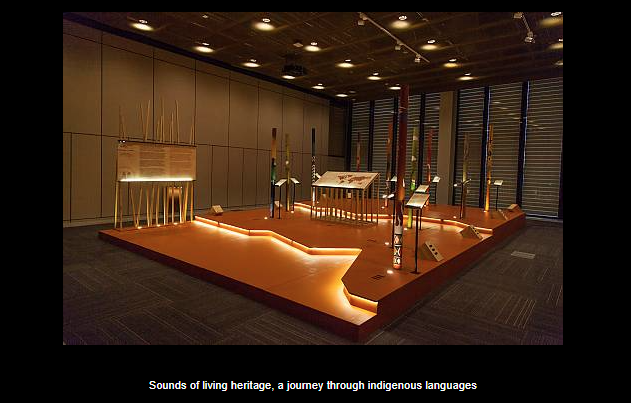• Sounds of living heritage, a journey through indigenous languages
In 2019, in celebration of the International Year of Indigenous Languages, and in recognition of the importance of safeguarding the living heritage of indigenous peoples, UNESCO organized the sound exhibition ‘Sounds of living heritage, a journey through indigenous languages’ at the fourteenth session of the Intergovernmental Committee of the 2003 Convention (9-14 December 2019, Bogotá). The sound exhibition highlighted the interconnectedness of language with the cultural practices and expressions of indigenous communities around the world.
In its Preamble, the 2003 Convention for the Safeguarding of the Intangible Cultural Heritage recognizes that “communities, in particular indigenous communities, groups and, in some cases, individuals, play an important role in the production, safeguarding, maintenance and re-creation of the intangible cultural heritage”.
While the practice and transmission of living heritage contributes to the ongoing vitality, strength and well-being of indigenous communities, language is the principal vehicle through which such living heritage is kept alive. Indigenous knowledge, expressed through language, allows communities to communicate and transmit a myriad of practices and expressions across generations, thereby contributing to a sense of continuity, belonging and mutual understanding.
The gradual disappearance of indigenous languages threatens the continued practice and transmission of living heritage, invariably leading to the loss of vital social and cultural knowledge, and ultimately threatening the existence of the communities themselves. In this respect, the safeguarding of indigenous languages is vital in sustaining the well-being of these communities and maintaining the world’s cultural diversity.
• Photo Exhibition “Living Heritage: Exploring the Intangible
Virtual exhibition accessible to visually impaired people
Visually impaired people make up 2.6 % of the world population, according to the World Health Organization. The adoption of The Convention on the Rights of Persons with Disabilities on 13 December 2006 demonstrates the world’s concern with ensuring “accessibility to the physical, social, economic and cultural environment, to health and education and to information and communication”. At the same time, the Intangible Cultural Heritage Convention gives great attention to ‘the need to build greater awareness, especially among the younger generations, of the importance of the intangible cultural heritage and of its safeguarding”. The Intangible Cultural Heritage Section’s virtual photo exhibition, “Living Heritage: Exploring the Intangible” offered a perfect opportunity to bring these two missions together to pioneer new approaches to increasing the accessibility of the Convention’s website and broadening the reach of UNESCO’s programmes in safeguarding living heritage.
A virtual photo exhibition on the internet opens up new technological possibilities to making visual content accessible to visually impaired persons. Provided that the content is correctly configured on-line, the visually impaired now have access through internet to an incredible amount of digital information interpretable by devices such as refreshable Braille displays, screen amplifiers or speech synthesizers. These technological tools are not just relevant to textual information: they can make photos and other images accessible at last to the visually impaired.
The Section of Intangible Cultural Heritage partnered with the Institut national des jeunes aveugles in Paris (INJA) to make the virtual exhibition “Living Heritage: Exploring the Intangible” fully accessible to visually impaired persons. Working together with INJA students, we addressed and improved the general browsability of the Intangible Heritage website. We also created visual descriptions of all of the photographs so that the visually impaired would have an experience comparable to that of other visitors to the virtual exhibition. Through these visual descriptions—read aloud to visually impaired visitors by their speech synthesizers or displayed on their Braille displays—they can now enjoy access to all of the content of the exhibition, increasing their awareness of intangible heritage and their enjoyment of the fundamental human rights enshrined in the Convention on the Rights of Persons with Disabilities.


